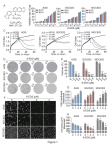A direct STAT3 inhibitor 6-ethoxydihydrosanguinarine exhibits anticancer activity in gastric cancer
Abstract
Signal transducer and activator of transcription 3 (STAT3) plays a key role in promoting tumor malignant progression. Suppression of hyperactivated STAT3 signaling has emerged as a potential therapeutic strategy for many cancer types. In this study, the effect of 6-ethoxydihydrosanguinarine (6-EDS), a secondary transformation product after dihydrosanguinarine is isolated from Macleaya (Papaveraceae), was evaluated on gastric cancer (GC). We demonstrated that 6-EDS inhibited the survival, migration, and invasiveness of GC cells in vitro. 6-EDS inhibited STAT3 phosphorylation and transcriptional activity to suppress the mRNA expression of downstream target genes associated with malignant survival, migration, and invasiveness of GC cells. Molecular docking found that 6-EDS directly bound the SH2 domain of STAT3. Molecular dynamics simulation suggested that 6-EDS inhibited the binding of phosphorylated and non-phosphorylated STAT3 to target DNA. A cellular thermal shift assay and microscale thermophoresis further confirmed the direct binding of 6-EDS to STAT3. Site-directed mutagenesis indicated that the S611 residue site in the SH2 domain of STAT3 is critical for 6-EDS binding. In vivo, 6-EDS reduced tumor growth in xenografted nude mice by blocking the STAT3 signaling. These findings indicate that 6-EDS, as a direct STAT3 inhibitor, could be a potent anticancer candidate for the therapy of GC.


